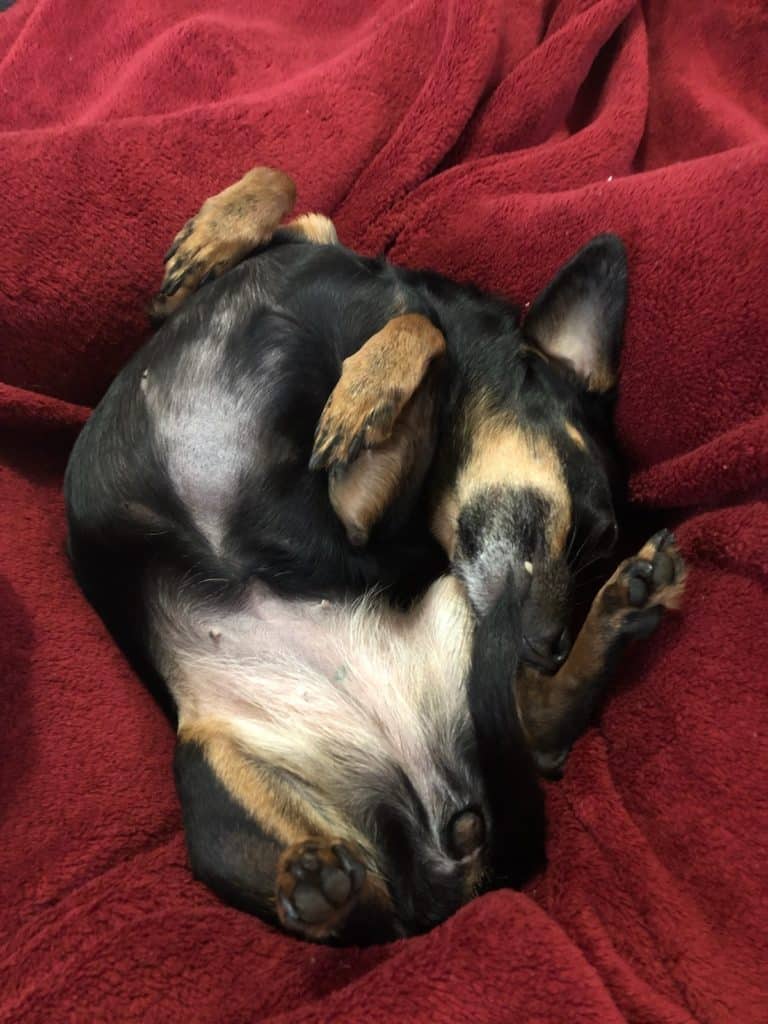 Lady is a 9 year old Miniature Pinscher who has been coming to our hospital since 2019. Upon Lady’s first appointment, it was noted by the owner that she was very fearful of the vet. When the doctor and technician approached Lady during her first appointment, Lady did try to nip and cried out at the staff. We were able to perform an exam that day, but Lady was extremely fearful of all the handling and instruments. Because we are Fear Free and only want the best for Lady and her care moving forward, we made a plan with the owner to work on modifying Lady’s behavior to become less fearful of the vet.
Lady is a 9 year old Miniature Pinscher who has been coming to our hospital since 2019. Upon Lady’s first appointment, it was noted by the owner that she was very fearful of the vet. When the doctor and technician approached Lady during her first appointment, Lady did try to nip and cried out at the staff. We were able to perform an exam that day, but Lady was extremely fearful of all the handling and instruments. Because we are Fear Free and only want the best for Lady and her care moving forward, we made a plan with the owner to work on modifying Lady’s behavior to become less fearful of the vet.
Our first recommendation for Lady was to be started on pre-visit pharmaceuticals. Pre-visit pharmaceuticals are medications that the veterinarian prescribes to help alleviate anxiety and stress prior to stressful situations. Sometimes, one or two medications are enough to take the edge off to handle pets in a Fear Free manner. However, there are pets that need a combination of medications with behavior modification. In Lady’s case she was too stressed about nail trims, more invasive portions of her exam, and blood draws that even with pre-visit pharmaceuticals, she had to be sedated. Pets that are highly anxious still when they come back with pre-visit pharmaceuticals will do better if they are sedated. When giving the sedation injection for Lady though, she would become so worked up that we had to pick her up with a thick towel to keep her still while we gave it. So for Lady, her best interest was to continue the pre-visit pharmaceuticals while working with Dr. Forbes on behavior modification to avoid having to sedate her forever and have her become less fearful of the veterinary hospital and procedures that come with it.
 During these behavior modification visits, there is nothing medically necessary done to the pet. We strictly focus on behavior, desensitizing, and counter conditioning the pet that the veterinary hospital is not a fearful place. Counter conditioning is a behavior modification technique in which a stimulus that creates a negative emotional response is paired with something known to create a positive emotional response in the animal. Desensitization is a behavior modification technique in which an animal is gradually and systematically exposed to a trigger stimulus until the stimulus no longer triggers an emotional response. We do this with positive reinforcement. Positive reinforcement is the process of rewarding or reinforcing desirable behavior in order to increase the likelihood that the behavior will be repeated in the future. For Lady, we found that she highly valued chicken and began working on her behavior modification
During these behavior modification visits, there is nothing medically necessary done to the pet. We strictly focus on behavior, desensitizing, and counter conditioning the pet that the veterinary hospital is not a fearful place. Counter conditioning is a behavior modification technique in which a stimulus that creates a negative emotional response is paired with something known to create a positive emotional response in the animal. Desensitization is a behavior modification technique in which an animal is gradually and systematically exposed to a trigger stimulus until the stimulus no longer triggers an emotional response. We do this with positive reinforcement. Positive reinforcement is the process of rewarding or reinforcing desirable behavior in order to increase the likelihood that the behavior will be repeated in the future. For Lady, we found that she highly valued chicken and began working on her behavior modification
During Lady’s behavior modification visits, Dr. Forbes first started with basics of getting Lady comfortable with her presence in the exam room. This involved tossing treats to Lady to get her to come explore the room and the doctor to become acquainted. From there we gave recommendations to the owner on training Lady to a mat or rug. This would give Lady a “place” where the training would be and if at any point Lady were uncomfortable, she could easily walk away from the mat indicating that training has stopped and she is uncomfortable. This gives Lady the opportunity to provide consent. If she’s ready to proceed, she will get on the mat and training would continue. This would aid in the behavioral modification as it would let Dr. Forbes know what procedures were okay with Lady and what procedures were not. In the beginning, most things were scary and uncomfortable for Lady, so we just focused on touching her. But with repetition and positive reinforcement, Lady became more and more comfortable with each visit with us petting her, staying on the mat, and eating her high value treat.
 Over time, we decided to have the owner work on training chin rest, as Lady was very nervous about approaches and instruments. Chin rest is a learned behavior where a pet holds its chin in the palm of your hand for the duration of each procedure, and then being rewarded for holding this position after the procedure is finished. This would give Lady something to focus on while the procedures are being done, knowing that a yummy treat would be rewarded after. As time went on, she no longer needed it for most of her exam. We now use it primarily to look in her mouth. Lady was and still is leery of the stethoscope. She will allow it for brief periods, but we’ve learned that she tolerates it better when we are holding her in our arms. This was a challenge as well, as Lady did not enjoy being picked up. So the owner taught lady a command to prep her that she is being picked up and we have practiced picking her up and then putting her down since.
Over time, we decided to have the owner work on training chin rest, as Lady was very nervous about approaches and instruments. Chin rest is a learned behavior where a pet holds its chin in the palm of your hand for the duration of each procedure, and then being rewarded for holding this position after the procedure is finished. This would give Lady something to focus on while the procedures are being done, knowing that a yummy treat would be rewarded after. As time went on, she no longer needed it for most of her exam. We now use it primarily to look in her mouth. Lady was and still is leery of the stethoscope. She will allow it for brief periods, but we’ve learned that she tolerates it better when we are holding her in our arms. This was a challenge as well, as Lady did not enjoy being picked up. So the owner taught lady a command to prep her that she is being picked up and we have practiced picking her up and then putting her down since.
With repetition and giving Lady the option to walk away, she began to become even more comfortable and eager to come here, knowing she would get rewarded for the positive behaviors. She has even developed a strong bond with Dr. Forbes. For procedures like a dental where a pet goes under anesthesia and needs pre-surgical blood work, a thorough exam and a catheter placed; we simply sedate Lady first so she is completely asleep for all of this so we don’t regress any of Lady’s progress. After these larger procedures, Lady usually does very well and actually seeks attention from Dr. Forbes- something she never used to do.
Currently, Lady is still doing behavior modifications to this day. The frequency of the modifications has lessened as Lady has gotten more comfortable with all of the handling and procedures. We are so proud of the owner and Lady for working so hard and coming so far. Congrats to Lady for Pet of the Month!
